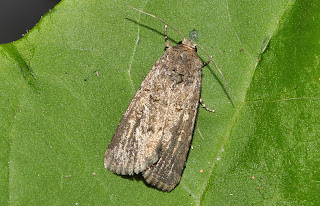Family: Noctuidae

 The beet armyworm or small mottled willow moth (Spodoptera exigua) is one of the best-known agricultural pest insects. It is also known as the asparagus fern caterpillar. It is native to Asia, but has been introduced worldwide and is now found almost anywhere its many host crops are grown. The voracious larvae are the main culprits. They are greenish-brown cutworms, soft and bulging caterpillars with dark longitudinal stripes. The adult is a drab brown or grey moth 2 to 3 cm in wingspan.
The beet armyworm or small mottled willow moth (Spodoptera exigua) is one of the best-known agricultural pest insects. It is also known as the asparagus fern caterpillar. It is native to Asia, but has been introduced worldwide and is now found almost anywhere its many host crops are grown. The voracious larvae are the main culprits. They are greenish-brown cutworms, soft and bulging caterpillars with dark longitudinal stripes. The adult is a drab brown or grey moth 2 to 3 cm in wingspan.
The larvae feed on the foliage of plants, and can completely defoliate small ones. Smaller larvae devour the parenchyma of leaves, so all that remains is the thin epidermis and veins. Larger larvae tend to burrow holes through thick areas of plants. For example, they burrow straight into a head oflettuce rather than neatly removing tissue from one particular leaf. This renders the produce unmarketable. They attack buds and new growth on plants, preventing flowers from opening, new leaves from sprouting, and vegetables from developing. As the smaller larvae move about they leave strands of silk behind, netting the leaves with a silvery film.
The wide host range of the beet armyworm includes asparagus, beans and peas, sugar and table beets, celery, cole crops, lettuce, potato, tomato, cotton, cereals, oilseeds, tobacco, many flowers, and a multitude of weed species. . The beet armyworm does not tolerate cold. It can overwinter in warm areas, such as Florida and Hawaii, but in colder areas, it dies off during the winter and the region is reinvaded by the adult moth as the weather warms and crop plants sprout.
In the British Isles, where it is an introduced species and not known to breed, the adult moth is known as the small mottled willow.From Wikipedia, the free encyclopedia

 The beet armyworm or small mottled willow moth (Spodoptera exigua) is one of the best-known agricultural pest insects. It is also known as the asparagus fern caterpillar. It is native to Asia, but has been introduced worldwide and is now found almost anywhere its many host crops are grown. The voracious larvae are the main culprits. They are greenish-brown cutworms, soft and bulging caterpillars with dark longitudinal stripes. The adult is a drab brown or grey moth 2 to 3 cm in wingspan.
The beet armyworm or small mottled willow moth (Spodoptera exigua) is one of the best-known agricultural pest insects. It is also known as the asparagus fern caterpillar. It is native to Asia, but has been introduced worldwide and is now found almost anywhere its many host crops are grown. The voracious larvae are the main culprits. They are greenish-brown cutworms, soft and bulging caterpillars with dark longitudinal stripes. The adult is a drab brown or grey moth 2 to 3 cm in wingspan.The larvae feed on the foliage of plants, and can completely defoliate small ones. Smaller larvae devour the parenchyma of leaves, so all that remains is the thin epidermis and veins. Larger larvae tend to burrow holes through thick areas of plants. For example, they burrow straight into a head oflettuce rather than neatly removing tissue from one particular leaf. This renders the produce unmarketable. They attack buds and new growth on plants, preventing flowers from opening, new leaves from sprouting, and vegetables from developing. As the smaller larvae move about they leave strands of silk behind, netting the leaves with a silvery film.
The wide host range of the beet armyworm includes asparagus, beans and peas, sugar and table beets, celery, cole crops, lettuce, potato, tomato, cotton, cereals, oilseeds, tobacco, many flowers, and a multitude of weed species. . The beet armyworm does not tolerate cold. It can overwinter in warm areas, such as Florida and Hawaii, but in colder areas, it dies off during the winter and the region is reinvaded by the adult moth as the weather warms and crop plants sprout.
In the British Isles, where it is an introduced species and not known to breed, the adult moth is known as the small mottled willow.From Wikipedia, the free encyclopedia
Photos Geri , 26/8/ 2015 by George Konstantinou
No comments:
Post a Comment